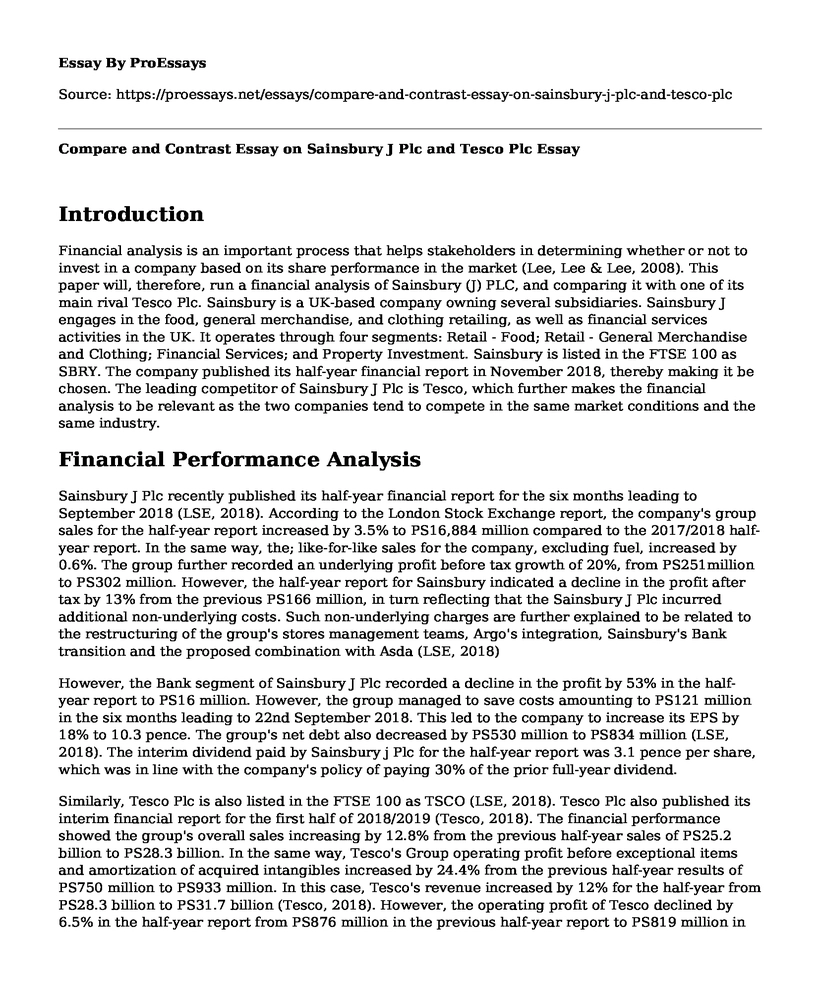Introduction
Financial analysis is an important process that helps stakeholders in determining whether or not to invest in a company based on its share performance in the market (Lee, Lee & Lee, 2008). This paper will, therefore, run a financial analysis of Sainsbury (J) PLC, and comparing it with one of its main rival Tesco Plc. Sainsbury is a UK-based company owning several subsidiaries. Sainsbury J engages in the food, general merchandise, and clothing retailing, as well as financial services activities in the UK. It operates through four segments: Retail - Food; Retail - General Merchandise and Clothing; Financial Services; and Property Investment. Sainsbury is listed in the FTSE 100 as SBRY. The company published its half-year financial report in November 2018, thereby making it be chosen. The leading competitor of Sainsbury J Plc is Tesco, which further makes the financial analysis to be relevant as the two companies tend to compete in the same market conditions and the same industry.
Financial Performance Analysis
Sainsbury J Plc recently published its half-year financial report for the six months leading to September 2018 (LSE, 2018). According to the London Stock Exchange report, the company's group sales for the half-year report increased by 3.5% to PS16,884 million compared to the 2017/2018 half-year report. In the same way, the; like-for-like sales for the company, excluding fuel, increased by 0.6%. The group further recorded an underlying profit before tax growth of 20%, from PS251million to PS302 million. However, the half-year report for Sainsbury indicated a decline in the profit after tax by 13% from the previous PS166 million, in turn reflecting that the Sainsbury J Plc incurred additional non-underlying costs. Such non-underlying charges are further explained to be related to the restructuring of the group's stores management teams, Argo's integration, Sainsbury's Bank transition and the proposed combination with Asda (LSE, 2018)
However, the Bank segment of Sainsbury J Plc recorded a decline in the profit by 53% in the half-year report to PS16 million. However, the group managed to save costs amounting to PS121 million in the six months leading to 22nd September 2018. This led to the company to increase its EPS by 18% to 10.3 pence. The group's net debt also decreased by PS530 million to PS834 million (LSE, 2018). The interim dividend paid by Sainsbury j Plc for the half-year report was 3.1 pence per share, which was in line with the company's policy of paying 30% of the prior full-year dividend.
Similarly, Tesco Plc is also listed in the FTSE 100 as TSCO (LSE, 2018). Tesco Plc also published its interim financial report for the first half of 2018/2019 (Tesco, 2018). The financial performance showed the group's overall sales increasing by 12.8% from the previous half-year sales of PS25.2 billion to PS28.3 billion. In the same way, Tesco's Group operating profit before exceptional items and amortization of acquired intangibles increased by 24.4% from the previous half-year results of PS750 million to PS933 million. In this case, Tesco's revenue increased by 12% for the half-year from PS28.3 billion to PS31.7 billion (Tesco, 2018). However, the operating profit of Tesco declined by 6.5% in the half-year report from PS876 million in the previous half-year report to PS819 million in the 2018/2019 half-year report (Tesco, 2018). However, the profit before tax for the Tesco Group increased by 2% from PS553 million to PS564 million. Following the performance, Tesco Plc proposed an increase in its interim dividends per share of 1.67p compared to the previous 1p. However, the diluted EPS for the group declined by 14.8% from 5.13p to 4.37p.
A comparison of the two firms shows that Tesco's group sales increased by a more significant percentage than Sainsbury. In the same way, the profit before tax for Tesco was higher than the one for Sainsbury (24% against 20%). Sainsbury's profit after tax further declined by a larger percentage (13.5%) compared to Tesco's (6.5%). The proposed dividends for Sainsbury were higher than the ones for Tesco Plc.
References
Lee, A. C., Lee, C. F., and Lee, J. C. 2008. Financial analysis, planning and forecasting: Theory and application. Singapore: World Scientific.
LSE. 2018. J Sainsbury plc. Interim Results for the 28 weeks to 22 September 2018. Available at https://www.londonstockexchange.com/exchange/news/market-news/market-news-detail/SBRY/13859293.html
Tesco Plc. 2018. Interim Results 2018/2019. Available at https://www.tescoplc.com/news/news-releases/2018/interim-results-201819/
Cite this page
Compare and Contrast Essay on Sainsbury J Plc and Tesco Plc. (2022, Oct 31). Retrieved from https://proessays.net/essays/compare-and-contrast-essay-on-sainsbury-j-plc-and-tesco-plc
If you are the original author of this essay and no longer wish to have it published on the ProEssays website, please click below to request its removal:
- Paper on Medical Insurance Terms
- Essay on Does Intel Have a Contingency Liability?
- Evaluation Essay on LG Corporation
- Maximizing Returns With Minimized Risk: Markowitz Portfolio Theory - Essay Sample
- Essay Example on Mutual Funds: Investing in Bonds, Stocks & More
- Commonwealth Bank of Australia: Leading Financial Service Provider - Essay Sample
- Essay Example on Global Customers' Bank Accounts Compromised by Phishing Emails







